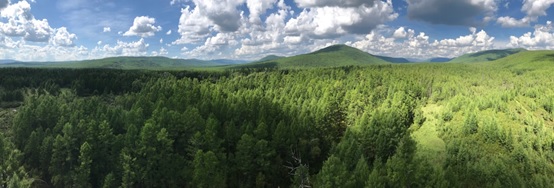The heterogeneity of vegetation community types within a terrestrial ecosystem, i.e., vegetation community complexity, can mediate its biological processes (e.g., energy harnessing, water and nutrient uptake and cycling), and therefore influences its stability and sustainability to environmental change. Revealing factors contributing to vegetation community complexity changes is key to understanding terrestrial ecosystem processes and formulating vegetation management policies.
Recently, scientists from the Institute of Botany of Chinese Academy of Sciences, together with collaborators, examined the spatial pattern of China’s vegetation community complexity and its temporal changes from the 1980s to 2015 using two vegetation maps of China as well as more than half a million field samples.
This study was recently published in Earth's Future.
They observed that spatially, China’s vegetation community complexity distribution is primarily dominated by elevation, which shows a strong hump-shaped relationship with elevation and a strong linear relationship with terrain roughness.
They revealed that the influence of climate conditions on vegetation community complexity varied by biogeographical regions. For example, when climate conditions become the factors limiting plant growth, they can be locally more influential than elevation.
The researchers identified that temporally, China’s vegetation community complexity shows a significant decreasing trend during the past 30 years, despite the observed vegetation greening trend. They demonstrated that both climatic and anthropogenic factors showed significant correlations with vegetation community complexity change. Increasing in mean annual temperature had a positive effect on vegetation community complexity, and the intensity of human activities has an overall negative influence on vegetation community complexity.
However, the researchers found that vegetation conservation and restoration efforts can have a positive effect on maintaining vegetation composition complexity. For example, regions covering the Three-North Shelter Forest Program and Grain for Green Project have the most significant clustered increases in vegetation community complexity, informing the critical role of vegetation management policies in achieving the sustainable development goal.
The study was supported by the Strategic Priority Research Program of Chinese Academy of Sciences, the Second Tibetan Plateau Scientific Expedition and Research Program (STEP), and the Information Plan of Chinese Academy of Sciences.

A Larix gmelinii forest located at the Great Xing’an Mountain (photo by HU Tianyu)
Article link:https://agupubs.onlinelibrary.wiley.com/doi/abs/10.1029/2021EF002553
Contact:
SU Yanjun
Institute of Botany, the Chinese Academy of Sciences
Email: ysu@ibcas.ac.cn
The heterogeneity of vegetation community types within a terrestrial ecosystem, i.e., vegetation community complexity, can mediate its biological processes (e.g., energy harnessing, water and nutrient uptake and cycling), and therefore influences its stability and sustainability to environmental change. Revealing factors contributing to vegetation community complexity changes is key to understanding terrestrial ecosystem processes and formulating vegetation management policies.
Recently, scientists from the Institute of Botany of Chinese Academy of Sciences, together with collaborators, examined the spatial pattern of China’s vegetation community complexity and its temporal changes from the 1980s to 2015 using two vegetation maps of China as well as more than half a million field samples.
This study was recently published in Earth's Future.
They observed that spatially, China’s vegetation community complexity distribution is primarily dominated by elevation, which shows a strong hump-shaped relationship with elevation and a strong linear relationship with terrain roughness.
They revealed that the influence of climate conditions on vegetation community complexity varied by biogeographical regions. For example, when climate conditions become the factors limiting plant growth, they can be locally more influential than elevation.
The researchers identified that temporally, China’s vegetation community complexity shows a significant decreasing trend during the past 30 years, despite the observed vegetation greening trend. They demonstrated that both climatic and anthropogenic factors showed significant correlations with vegetation community complexity change. Increasing in mean annual temperature had a positive effect on vegetation community complexity, and the intensity of human activities has an overall negative influence on vegetation community complexity.
However, the researchers found that vegetation conservation and restoration efforts can have a positive effect on maintaining vegetation composition complexity. For example, regions covering the Three-North Shelter Forest Program and Grain for Green Project have the most significant clustered increases in vegetation community complexity, informing the critical role of vegetation management policies in achieving the sustainable development goal.
The study was supported by the Strategic Priority Research Program of Chinese Academy of Sciences, the Second Tibetan Plateau Scientific Expedition and Research Program (STEP), and the Information Plan of Chinese Academy of Sciences.

A Larix gmelinii forest located at the Great Xing’an Mountain (photo by HU Tianyu)
Article link:https://agupubs.onlinelibrary.wiley.com/doi/abs/10.1029/2021EF002553
Contact:
SU Yanjun
Institute of Botany, the Chinese Academy of Sciences
Email: ysu@ibcas.ac.cn
